Top Industry Leaders in the Oilfield Equipment Rental Services Market

*Disclaimer: List of key companies in no particular order
Beneath the scorching deserts and icy tundras, a hidden battleground roars – the oilfield equipment rental services market. This multi-billion dollar arena pulsates with activity, with established giants, nimble innovators, and regional specialists vying for a share of the machinery that fuels our world. Let's delve into the key strategies, market dynamics, and future trends shaping this dynamic landscape.
Top Companies in the Oilfield Equipment Rental Services industry includes,
- Halliburton Co. (U.S.)
- Oil States International Inc. (U.S.)
- Schlumberger Ltd (U.S.)
- Superior Energy Services Inc. (U.S.)
- Weatherford International Ltd (Switzerland)
- Baker Hughes (U.S.)
- National Oilwell Varco (U.S.)
- Cameron International Inc.(U.S.)
- Transocean Ltd. (Switzerland)
- B&B Oilfield Equipment Corp (U.S.)
Key Player Strategies:
Global Titans: Companies like Halliburton, Schlumberger, and Baker Hughes leverage their extensive experience, global reach, and diverse equipment portfolios to maintain their dominance. They cater to large-scale exploration and production projects, offering drilling rigs, pressure control systems, and specialized tools for various environments. Halliburton's iComplete well construction program exemplifies their focus on integrated solutions and project management expertise.
Technology Disruptors: Startups like Welltec and Cudd Energy Services are disrupting the market with digital twins, automated equipment monitoring, and data-driven optimization solutions. They cater to tech-savvy operators seeking increased efficiency, reduced downtime, and real-time performance insights. Cudd Energy Services' IntelliWell platform showcases their focus on remote monitoring and data-powered decision making.
Cost-Effective Challengers: Chinese manufacturers like Shandong Honghua Petroleum Machinery and SJTC Oil Tools are making waves with competitively priced equipment, targeting budget-conscious operators in emerging markets. They focus on affordability and basic functionality, offering alternatives to premium brands. SJTC Oil Tools' wide range of drilling tools demonstrates their focus on cost-effective solutions for essential operations.
Regional Champions: Companies like National Oilwell Varco in North America and Weatherford in the Middle East excel in their domestic markets, leveraging strong local relationships and deep understanding of regional regulations. They offer tailored equipment configurations and services optimized for specific geological conditions. National Oilwell Varco's NOV Completion Tools division illustrates their focus on regional adaptation and specialized solutions.
Factors for Market Share Analysis:
Equipment Portfolio Breadth: Offering a diverse range of equipment for various drilling and production activities (drilling rigs, well services, completion tools) and well types (conventional, unconventional) caters to a wider customer base. Companies with comprehensive portfolios gain an edge.
Technology Innovation: Investing in R&D for next-generation technologies like automated drilling systems, advanced sensors, and digital platforms for real-time performance monitoring is crucial for staying ahead of the curve. Companies leading in innovation attract early adopters and premium contracts.
Cost and Affordability: Balancing cutting-edge features with competitive pricing is vital for mass adoption, particularly in cost-sensitive markets. Companies offering affordable solutions without compromising safety or performance stand out.
Operational Efficiency and Service Quality: Ensuring timely equipment delivery, efficient on-site operations, and responsive maintenance services is paramount for customer satisfaction and project success. Companies with strong operational expertise and service quality gain trust and market share.
New and Emerging Trends:
Digitalization and Automation: Implementing automation tools, including robotic drilling rigs and AI-powered decision support systems, can improve safety, optimize performance, and reduce operational costs. Companies embracing digitalization cater to the demand for increased efficiency and data-driven solutions.
Focus on Sustainability: Utilizing low-emission equipment, implementing renewable energy sources for field operations, and minimizing environmental impact during projects are becoming increasingly important. Companies demonstrating environmental consciousness attract responsible investors and potential regulatory benefits.
Focus on Unconventional Resources: Adapting equipment and services for shale oil and gas extraction, deepwater drilling, and other unconventional resource exploration presents significant growth opportunities. Companies specializing in these areas stand out in this niche market.
Collaboration and Partnering: Forming strategic partnerships with technology providers, regional specialists, and other industry stakeholders can expand service offerings, improve market reach, and provide more comprehensive solutions. Companies actively engaging in strategic collaborations gain an edge.
Overall Competitive Scenario:
The oilfield equipment rental services market is a dynamic and complex space with diverse players employing varied strategies. Established giants leverage their reach and diverse portfolios, while technology disruptors introduce innovative solutions. Cost-effective challengers cater to budget-conscious buyers, and regional champions excel in specific markets. Factors like equipment portfolio, technological innovation, affordability, and operational efficiency play a crucial role in market share analysis. New trends like digitalization, sustainability focus, unconventional resources, and strategic collaboration offer exciting growth opportunities. To succeed in this evolving market, players must prioritize innovation, cater to diverse project needs, embrace sustainable practices, and explore technology-driven solutions. By striking black gold in adaptability and strategic partnerships, they can secure a dominant position in this ever-changing landscape.

